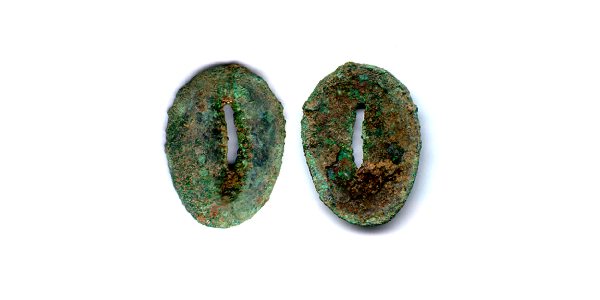 |
| Via. |
My mother always told me to carry a cowry shell in my wallet for good luck. Since she comes from India, I began to wonder about the roots of this belief.
We know that cowry shells are the longest-lived and most widely-spread currency of our species—in use perhaps as early as 4,000 years ago, and important to cultures ranging from Oceania to West Africa and most everything in between.
 |
| Credit: Bin im Garten via Wikimedia Commons. |
They've been found in association with coins from sites in India dating to the first century AD according to the Conchological Society of Great Britain and Ireland.
But they seem to have been used even earlier in ancient China. Here's an excerpt from an interesting paper by Colin Narbeth:
The use of cowry shells as a medium of exchange goes back to the dawn of Chinese civilization. One of the earliest written references is that of an historian, Ssu-ma Ch'ien, of c. 145-86 BC. He mentions cowries as being used as money in the Shang and Chou periods. In the Shang Dynasty [1766-112BC] the character PEI was part of the Chinese language. The earliest form, the archaic script which developed into Seal Script, was merely a rough picture of the ventral side of a cowry [貝]. It was so important that PEI was adopted as one of the 214 radicals—the foundations characters of the language. Today 84 Chinese characters have PEI as the main foundation. Finds of cowry shells, sometimes in very large quantities, have come to light in tomb excavations and the opinion of most Chinese archaeologists today is that they were there as money.
There were times the Chinese couldn't get enough shells and manufactured them from wood, stone, bone, bronze, gold, silver, jade, and other semi-precious stones.
The first metal currency was actually imitation cowry shells.
 |
| Copper/bronze imitation cowry shell money. Via. |
 |
| Stone imitation cowry shell money. Via. |
 |
| Pottery imitation cowry shell money. Via. |
The species most commonly used as currency—the money cowry—was named by the father of modern taxonomy Carl Linnaeus as Cypraea moneta in 1758.
Today's scientific name is Monetaria moneta.
 |
| Live money cowry. Via. |
From the Arab merchant Sulayman (851 AD) we learn that at one time, in the 9th century, the Maldives had a very beautiful and wealthy Queen. Having used up her Treasury of cowries she resorted to sending the Maldive maidens to collect large palm leaves from the coconut trees. These were then laid in the shallow water. Soon thousands of cowries would crawl onto the leaves—to be suddenly pulled out of the water and left high and dry to die before being sent to replenish the Queen’s Treasury. This account was confirmed by Masudi of Baghdad, famous Arab historian of the 10th century.
In the 17th century Pyrard de Laval was wrecked on the Maldive Islands and stayed there for two years. He wrote: "They called them (cowries) Boly and export to all parts an infinite quantity, in such wise that in one year I have seen 30 or 40 whole ships loaded with them without other cargo. All go to Bengal for there only is there a demand for a large quantity at high prices. The people of Bengal use them for ordinary money although they have gold and silver and plenty of other metals; and what is more strange, kings and great lords have houses built expressly to store these shells and treat them as part of their treasure."
 |
| Modern Maldives currency with cowry shell design. Via Wikimedia Commons. |
As you might imagine, with so much pressure on the stocks, Monetaria moneta eventually became scarce in Maldivian waters. Attention switched to a similar species, Monetaria annulus. From Narbeth:
These could be found in huge quantities off the Zanzibar coast... By 1851 inflation was undermining the trade. Cowries were so plentiful and so cheap that counting them became a very time consuming matter. Town governors packed them in sacks—20,000 to the sack. But when used between private individuals they had to be counted, in fives. Barth wrote: "The general custom is to count them in fives, in which operation some are very expert, and then to form heaps of 200 or 1000 each. The counting of 500,000 shells is a really heroic work."
 |
| Credit: Sarah Starkweather via Flickr. |
My mother and her kin came from Bengal. So perhaps the habit of carrying a cowry shell in your wallet as good luck—specifically, as monetary good luck—is left over from the time when cowry shells were real money.
Interestingly, Narbeth writes about periods of transition in China when rulers tried to abolish cowry currency in favor of a metal currency, only to have the next ruler abolish the upstart metal in favor of cowry currency.
 |
| Cowry eggs. Via. |
In times of such uncertainty, it might have been a good idea to keep some cowry power in your wallet. Just in case it got valuable again.
I'm still doing it.









0 comments:
Post a Comment